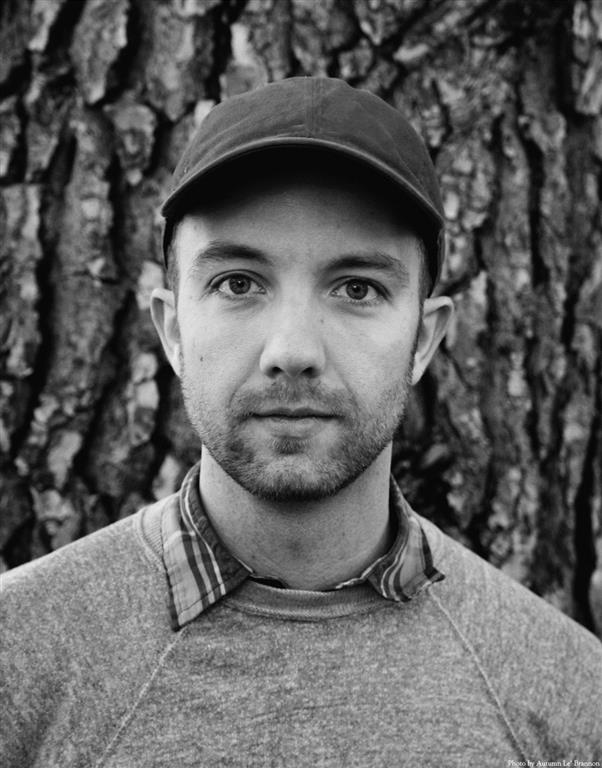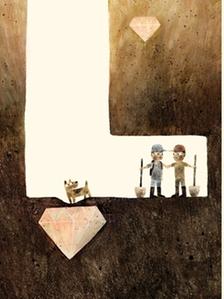Mac Barnett and Jon Klassen's first collaboration, Extra Yarn, earned a Caldecott Honor. Barnett has also collaborated with Jon Scieszka on Battle Bunny, illustrated by Matthew Myers, and written a number of picture books as well as his Brixton Brothers series of detective novels. Klassen won the 2013 Caldecott Medal for his book This Is Not My Hat, and also illustrated Lemony Snicket's The Dark. Here Barnett and Klassen discuss their collaboration on the tale of two brothers who seek the "spectacular" and find themselves in a situation, Sam & Dave Dig a Hole (Candlewick, October 14), reviewed below.

|
|
| Mac Barnett (photo: Sonya Sones) |
|
Mac, you've said that Extra Yarn began with an image in Jon's portfolio. Was that the case with Sam & Dave Dig a Hole, too?
Mac Barnett: I did write Extra Yarn with Jon in mind. [For this book,] we were having breakfast together in L.A. and we were talking about digging a hole. Anytime I do a picture book, for me to get excited about it, it needs a visual element. Jon started sketching on a napkin on the spot.
And did you come up with the idea of the type matching the ground level at that point, too?
Jon Klassen: That was the hook for me, that the type would go down with the hole. We tried to go linear, but it worked better for the type to go where the brothers are. It was a happy accident that happened in the beginning, wasn't it Mac?
MB: Yes, I think it was an accident. We wanted to keep it nice and punchy at the beginning, and once you establish some trust and a rhythm, then you have more of a chance to have a longer text.
Those were the elements we got excited about. That ending was there from the start, too, not how it would be executed, but that they'd land in a place that looked similar but was a different place than where they started. I went off [from the diner] and wrote the manuscript but then, kind of unusually, we came back together. We worked super closely on this one.

|
|
| Jon Klassen | |
How closely did you work?
MB: Jon and I tend to open up an audio link between our computers during the day. We did it while Jon was doing the rough for the book. Sometimes he'd have a visual idea he loved that the text didn't really support, so I'd create text that he wanted to have happen.
JK: Because so much was going on outside--in the dirt--we needed to keep in contact about it. Since the ending was so hooked up to all that stuff, it needed to talk to the other stuff. We had to keep digging together.
Was the dog always part of the story?
JK: The dog initially was left at the top, the way the cat is now. The camera showed that they'd dug and were about to fall through with their own weight. As soon as we brought the dog down, and knowing the things that were there, it really unlocked a lot of stuff.
MB: It changed everything. I thought, "This is it! The dog's coming along!"
JK: Of course, the dog wants to come along, and the cat stays behind and says, "You guys are crazy." If it's just them and they fall through, then it feels like a dream, and it might not have happened at all. The idea that the dog would prompt the breakthrough at the bottom, and with the dog being awake the whole time, we know they're experiencing it.
MB: The dog's an intensifier, rather than a double beat. He intensifies the frustration. When I read this aloud to kids, there's more shouting than with any other book. "NOOOO. I can't believe they missed all those gems!" The dog's saying, "There is a gem right here."
Are Sam and Dave brothers? We noticed after several rereadings that the animal cookies are wrapped in "their" grandfather's kerchief.
MB: That's the moment you learn their relationship. It's inferential. Jon said, to me, "These guys seem like brothers." I really liked that. The only thing keeping them from being brothers was the pronoun "his" for the grandfather's kerchief.
JK: It cleans up the universe a little for us, too. This way they live in the same house. As little detail as there is in the words, there's a complex relationship, one's leading the other. When I was little, I was sensitive to that kind of thing, as far as who's in charge and who's not in charge. Brothers are always dynamic, it's always changing, and it's such an interesting relationship.
MB: One of the big moments is that page turn where they've gone in two different directions around the gem, and that wasn't initially in the text, and Jon drew it and said, "Look at this one." I was so worried, I just didn't know if our guys would split up. We talked about it over the course of two days. It would be scary for them. It felt like a big deal. It just has to be a big deal for them, too. That seemed like a good reason to do it. That moment with Sam having a hand on Dave's shoulder--everything about their relationship is in that piece of art.
 Jon, what made you decide not to show mouths on Sam and Dave?
Jon, what made you decide not to show mouths on Sam and Dave?
JK: I avoid mouths a lot of times. When characters have dialogue, you're pinpointing a moment a little too exactly. It's hard to parse between your sensibilities and the story. I like the moments between the action. You rarely see the kids digging; they're always sitting, having dug. If you have them digging, you wonder where the pile of dirt is. If you don't show that happening, it doesn't come up as much.
MB: Time is an issue, too. For the book trailer, Jon and I dug a hole. It takes a long time; it's a lot of work. That's part of the illustrator's job, too. In Extra Yarn, when you turn the page and someone who wasn't wearing a sweater is wearing a sweater, each page turn allows for the passage of time. The mouths fit into that same rationale.
Let's talk about the ending. How do kids react when you read this to them?
MB: If I read it in front of a big group, the kids notice the tree first. It will spread from those few kids across the class. They'll point out all the differences they see. I'll say, "What do you think happened?" Usually the first thing kids say is, "They've entered a different dimension," "They've gone through a portal," or "They've approached Sam's house." It's a book about noticing and not noticing. Really it's a feeling we're trying to create.
JK: it gets interesting as soon as kids are asked to explain what happened. I like the idea of a kid looking at it by themselves, and maybe the second or third time it might come as a neat shock, that someone did this on purpose: "Welcome to the secret of the book." It's not really a secret. The apple tree at the beginning gets a full page; the pear tree gets a full page [at the end], too. I like the idea of a kid flipping back and forth and comparing them.
MB: When I was little, I liked mystery, ambiguity--it's what I've always loved in books. Literary ambiguity, mystery, lingering questions, these are things that kids are more willing to accept than adult readers. --Jennifer M. Brown

